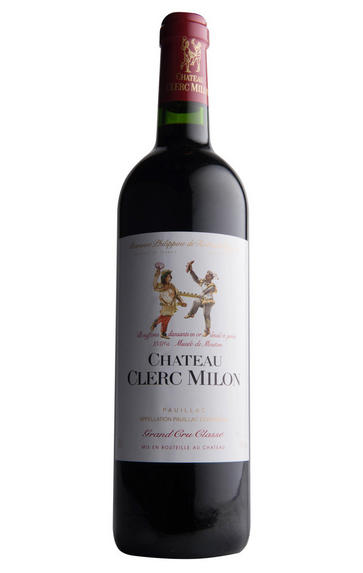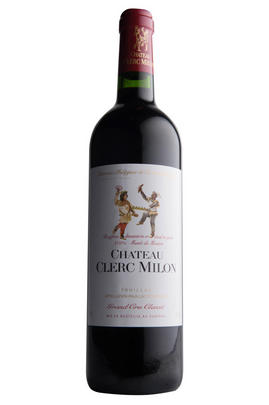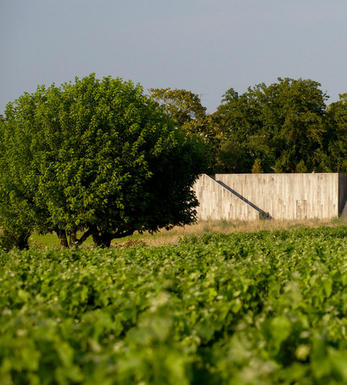
2021 Château Clerc Milon, Pauillac, Bordeaux

Critics reviews
The 2021 Clerc Milon, aged in 55% new oak, contains a little more Cabernet Franc than usual. It has a slightly savory nose displaying moderate vigor and black fruit infused with touches of brown spice. The palate is medium-bodied with supple tannins, and quite broad and fleshy. The plush finish makes me think this will drink well in its youth. Fine, though I lean toward the d'Armailhac this year. 13% alcohol)
Drink 2027 - 2039
Neal Martin, Vinous.com (May 2022)
The 2021 Clerc Milon is gorgeous. Beams of tannin lend energy and direction to an alluring Clerc Milon that marries fruit density with a classic sense of structure that is quite appealing
Drink 2029 - 2041
Antonio Galloni, Vinous.com (May 2022)
55% new oak. 57IPT. 3.73ph. Caroline Artaud technical director as of this vintage. Strong candidate for upscore in bottle.
Sappy, concentrated, powerful, this is a wine that has a lot of power naturally and in a vintage like 2021 (and with higher Cabernet Franc and higher Carmanère than the past few years), it runs the risk of being austere. Certainly you feel a sterner character than over the past few years, but there is flexibility in the tannins, and well-worked blackcurrant and blackberry fruit. Will benefit from fattening up through the mid palate over ageing, because all the elements are here.
Drink 2025 - 2040
Jane Anson, JaneAnson.com (May 2022)
The 2021 Clerc Milon has turned out very well indeed, offering up aromas of dark berries and minty cassis mingled with hints of violets and pencil shavings. Medium to full-bodied, velvety and concentrated, it's impressively deep and layered, with an ample core of fruit, lively acids and sweet, chalky tannins.
Drink 2027 - 2045
William Kelley, Wine Advocate (February 2024)
59% Cabernet Sauvignon, 28% Merlot, 10% Cabernet Franc, 1.5% Petit Verdot, 1.5% Carmenère. Cask sample.
More restrained aromatically than some this year. Dark fruit and savoury nuance. Palate solid and firm with plenty of freshness. Tannins present but well rounded, tightening on the finish to give some persistence. Pleasantly dry finish. Pauillac muscle but in a low-key form.
Drink 2028 - 2040
James Lawther, JancisRobinson.com (May 2022)
Polished and well-structured red with a medium body and firm but creamy and broad tannins. Perfumed already, with sandalwood, blackberry and currant character. Crushed stones. Tea leaves, too. Firm and solid to the end. Very solid for the vintage. 59% Cabernet Sauvignon, 28% Merlot, 10% Cabernet Franc, 1.5% Carmenere and 1.5% Petit Verdot.
James Suckling, JamesSuckling.com (May 2022)
1.5% Camenère and 1.5 Petit Verdot complete the blend. 3.73pH.
Bramble and hedgerow notes, some smoke, tobacco, chocolate, liquorice-laced black fruits and graphite on the nose. Seriously captivating with the complexity continuing on the palate, comprising coffee, cedar, clove and cinnamon alongside plump and plush layers of succulent and concentrated blackcurrant and black cherry fruit and racy acidity.
The 59% Cabernet Sauvignon influence is in sharp focus, right to the fore, wanting all the attention, but at the same time this has a beautiful and generous fragrance to it from 10% Cabernet Franc. Refined and elegant, I love the presentation and the structure, giving such length and freshness on the long finish. An excellent Clerc this year which really stands out.
Drink 2025 - 2045
Georgina Hindle, Decanter.com (April 2022)
The 2021 Château Clerc Milon is based on 59% Cabernet Sauvignon, 28% Merlot, 10% Cabernet Sauvignon, and the rest Carmenère and Petit Verdot. It has more pure cassis and graphite as well as medium-bodied richness, ripe, polished tannins, remarkable purity of fruit, and a great finish.
Drink 2026 - 2045
Jeb Dunnuck, JebDunnuck.com (June 2022)
About this WINE

Château Clerc Milon
Classified as a Fifth Growth in 1855, Château Clerc Milon is one of a trinity of Pauillac classified growths owned by the Baron Philippe de Rothschild family. Baron Philippe began renovation and restoration here in 1970 – work that was later championed by his daughter Baroness Philippine until her death in 2014.
Baroness Philippine’s children, Camille and Philippe Sereys de Rothschild and Julien de Beaumarchais de Rothschild, now continue their mother’s legacy. In recent times, the estate has flourished under the careful stewardship of Director Jean-Emmanuel Danjoy. In 2020, his role expanded to include Château Mouton Rothschild and Château d’Armailhac and the talented winemaker Caroline Artaud joined the team at Château Clerc Milon in the capacity of Director.
Château Clerc Milon’s vineyard holdings – 41 hectares – neighbour two first growths. More than half of the vines are Cabernet Sauvignon (51.5%), with the remainder being Merlot (37%), Cabernet Franc (8%), Petit Verdot (2%) and Carmenère (1.5%). The vines have an average age of 48 years. Harvesting here is done by hand.

Pauillac
Pauillac is the aristocrat of the Médoc boasting boasting 75 percent of the region’s First Growths and with Grand Cru Classés representing 84 percent of Pauillac's production.
For a small town, surrounded by so many familiar and regal names, Pauillac imparts a slightly seedy impression. There are no grand hotels or restaurants – with the honourable exception of the establishments owned by Jean-Michel Cazes – rather a small port and yacht harbour, and a dominant petrochemical plant.
Yet outside the town, , there is arguably the greatest concentration of fabulous vineyards throughout all Bordeaux, including three of the five First Growths. Bordering St Estèphe to the north and St Julien to the south, Pauillac has fine, deep gravel soils with important iron and marl deposits, and a subtle, softly-rolling landscape, cut by a series of small streams running into the Gironde. The vineyards are located on two gravel-rich plateaux, one to the northwest of the town of Pauillac and the other to the south, with the vines reaching a greater depth than anywhere else in the Médoc.
Pauillac's first growths each have their own unique characteristics; Lafite Rothschild, tucked in the northern part of Pauillac on the St Estèphe border, produces Pauillac's most aromatically complex and subtly-flavoured wine. Mouton Rothschild's vineyards lie on a well-drained gravel ridge and - with its high percentage of Cabernet Sauvignon - can produce (in its best years) Pauillac's most decadently rich, fleshy and exotic wine.
Latour, arguably Bordeaux's most consistent First Growth, is located in southern Pauillac next to St Julien. Its soil is gravel-rich with superb drainage, and Latour's vines penetrate as far as five metres into the soil. It produces perhaps the most long-lived wines of the Médoc.
Recommended Châteaux
Ch. Lafite-Rothschild, Ch. Latour, Ch. Mouton-Rothschild, Ch. Pichon-Longueville Baron, Ch. Pichon Longueville Comtesse de Lalande, Ch. Lynch-Bages, Ch. Grand-Puy-Lacoste, Ch, Pontet-Canet, Les Forts de Latour, Ch. Haut-Batailley, Ch. Batailley, Ch. Haut-Bages Libéral.

Cabernet Sauvignon Blend
Cabernet Sauvignon lends itself particularly well in blends with Merlot. This is actually the archetypal Bordeaux blend, though in different proportions in the sub-regions and sometimes topped up with Cabernet Franc, Malbec, and Petit Verdot.
In the Médoc and Graves the percentage of Cabernet Sauvignon in the blend can range from 95% (Mouton-Rothschild) to as low as 40%. It is particularly suited to the dry, warm, free- draining, gravel-rich soils and is responsible for the redolent cassis characteristics as well as the depth of colour, tannic structure and pronounced acidity of Médoc wines. However 100% Cabernet Sauvignon wines can be slightly hollow-tasting in the middle palate and Merlot with its generous, fleshy fruit flavours acts as a perfect foil by filling in this cavity.
In St-Emilion and Pomerol, the blends are Merlot dominated as Cabernet Sauvignon can struggle to ripen there - when it is included, it adds structure and body to the wine. Sassicaia is the most famous Bordeaux blend in Italy and has spawned many imitations, whereby the blend is now firmly established in the New World and particularly in California and Australia.


Buying options
Add to wishlist
Description
Cabernet Sauvignon 59%, Merlot 28%, Cabernet Franc 10%, Petit Verdot 1.5%, Carmenère 1.5%.
Jean-Emmanuel Danjoy’s work here over the last decade has made Clerc Milon one of the Left Bank’s most-improved châteaux. Jean-Emmanuel has since moved up to run Mouton Rothschild; Caroline Artaud is now in charge. The property’s cooler clay soils can be a challenge in years like 2021, but vineyard health is now such that the fruit was all in by 6th October. This is very polished and compact, if not as flamboyant as in recent vintages. But there is plenty of weave and texture between the tannins and black-fruit notes. The finish is persistent and long.
Drink 2027 - 2042
Our score: 17.5/20
Berry Bros. & Rudd
wine at a glance
Delivery and quality guarantee